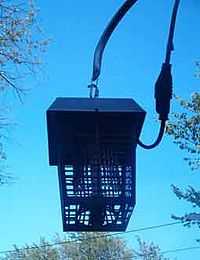Bug zapper

A bug zapper, more formally called an electrical discharge insect control system, is a device that attracts and kills flying insects that are attracted by light. A light source attracts insects to an electrical grid, where they are electrocuted by touching two wires with a high voltage between them. The name stems from the characteristic zap sound produced when an insect is electrocuted.
History
In its October 1911 issue, Popular Mechanics magazine had a piece showing a model "fly trap" that used all the elements of a modern bug zapper, including electric light and electrified grid. The design was executed by two unnamed Denver men and was conceded to be too expensive to be of practical use. The device was 10 by 15 inches (25 by 38 cm), contained 5 incandescent light bulbs, and the grid was 1⁄16-inch (1.59 mm) wires spaced 1⁄8-inch (3.17 mm) apart with a voltage of 450 volts. Users were supposed to bait the interior with meat.[1]
According to the US Patent and Trademark Office, the first bug zapper was patented in 1934 by William F. Folmer and Harrison L. Chapin. They were issued U.S. Patent 1,962,439.[2]
Separately, Dr. W.B. Herms, a professor of parasitology at the University of California had been working on large commercial insect traps for over 20 years for protection of California's important fruit industry. In 1934 he introduced the electronic insect killer that became the model for all future bug zappers.[3]
Design
Bug zappers are usually housed in a protective cage of plastic or grounded metal bars to prevent people or animals from touching the high voltage grid. A light source is fitted inside, often a fluorescent lamp designed to emit violet and ultraviolet light, which is visible to insects and attracts them. The light is surrounded by a pair of interleaved bare wire grids or spirals. The distance between adjacent wires is typically about 2 mm (0.079 in). A high-voltage power supply powered by mains electricity, which may be a simple transformerless voltage multiplier circuit made with diodes and capacitors, generates a voltage of 2,000 volts or more, high enough to conduct through the body of an insect which bridges the two grids, but not high enough to spark across the air gap. Enough electrical current flows through the small body of the insect to heat it to a high temperature.[4] The impedance of the power supply and the arrangement of the grid is such that it cannot drive a dangerous current through the body of a human.
Many bug zappers are fitted with trays that collect the electrocuted insects; other models are designed to allow the debris to fall to the ground below.
Drawbacks
External traps
These traps are not effective at killing biting insects (female mosquitoes and other insects),[5][6] being much more effective at attracting and killing other harmless and beneficial insects. A study over a summer found that 13,789 insects were killed, of which 31 were biting insects.[6] Mosquitoes are attracted to carbon dioxide and water vapor in the breath of mammals, not ultraviolet light.[6] However there are now bug zappers that emit carbon dioxide or use an external bait, such as octenol, to better attract biting insects into the light.
Scattering
Research has shown that when insects are electrocuted bug zappers can spread a mist containing insect parts up to about 7 feet (2.1 m) from the device. The air around the bug zapper can become contaminated by bacteria and viruses that can be inhaled by, or settle on the food of people in the immediate vicinity.[7][8] The U.S. Food and Drug Administration (FDA) advise the bug zapper should not be over a food preparation area, and insects should be retained within the device.[9] Scatter-proof designs are produced for this purpose.
References
- ↑ "An Electric Death Trap for the Fly". Popular Mechanics. October 1911. Retrieved 5 February 2009.
- ↑ "Easier Ways Of Doing It", November 1931, Popular Mechanics article bottom of page 751
- ↑ "Electric Chair For Insects Helps Farmers", 1990 march
- ↑ Freudenrich, Craig. "Bug Zappers". How Stuff Works. Retrieved 2009-10-22.
- ↑ Science Daily: "Snap! Crackle! Pop! Electric Bug Zappers Are Useless For Controlling Mosquitoes, Says UF/IFAS Pest Expert" July 30, 2013. http://www.sciencedaily.com/releases/1997/07/970730060806.htm
- ↑ 6.0 6.1 6.2 Lewis, Donald (1996-06-14). "Bug Zappers are Harmful, Not Helpful". Horticulture and Home Pest News (Iowa State University). IC-475 (15). Retrieved 2009-10-22.
- ↑ "Can bug zappers help transmit diseases?". HowStuffWorks. Retrieved 30 April 2009.
- ↑ Urban, James E.; Alberto Broce (October 2000). "Electrocution of House Flies in Bug Zappers Releases Bacteria and Viruses". Current Microbiology (Kansas State University) 41 (4). doi:10.1007/s002840010132. Archived from the original on 2007-11-04. Retrieved 2009-10-22.
bug zappers not only pose an immediate threat because of the release of bacteria and viruses, but they also release insect particles which are potential allergens and/or cause various respiratory conditions
- ↑ "Chapter 6: Physical Facilities; Insect Control Devices, Design and Installation; 6-202.13". FDA Food Code 2009: Annex 3. U.S. Food and Drug Administration. 2009. Retrieved 2013-06-23.